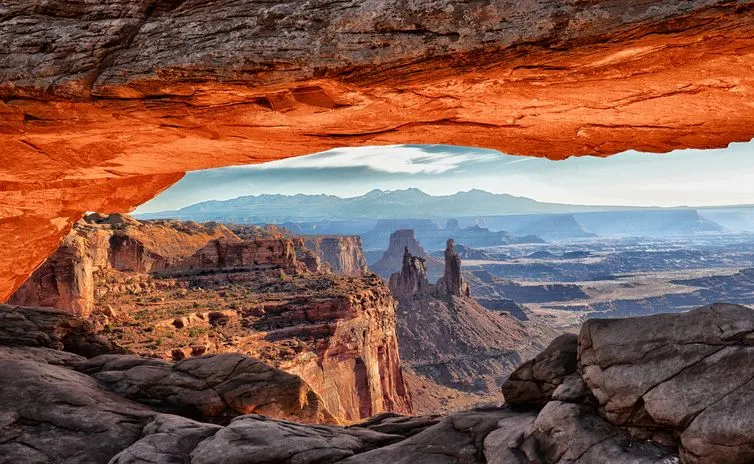6 Beautiful Parks in the America
1. Bryce Canyon National Park
Bryce Canyon in Utah maintains its position as one of the American southwest's most authentic attractions. This western National Park presents an array of "hoodoos" geological shapes made through thousands of years of weathering. The void-like features of Bryce Canyon make up a collection of natural amphitheaters that were carved into the Paunsaugunt Plateau despite its traditional name as a "canyon." From sunrise to sunset the vivid hoodoo colour range stretching from red to white to orange produces one of nature's most eye-catching displays.
Considered a paradise by active hikers. Travellers can spend their own timeframe exploring the stunning sights of this park which features around 50 kilometers of trail maps. The Navajo Loop together with the Queens Garden Trail direct visitors directly into the amphitheater region for hiking among hoodoos. Bryce Canyon is particularly recognized for its unique wildlife: Visitors can observe three distinct species within the park boundaries: mule deer, golden eagles and the recovering California condor.
One of the distinctive qualities of Bryce Canyon is the remarkable beauty of its night sky. Thanks to its isolation from large towns, the park offers great circumstances for stargazing. Many people take advantage of ranger-led programs conducted at night to see the Milky Way or attend events like the Bryce Canyon Astronomy Festival. The stillness and peace of the place add to the immersion experience within this conserved environment.
2. Zion National Park

Visitors seeking nature-bound exploration and outdoor adventure should put Zion National Park in Utah at the top of their destination list. Zion National Park stands as one of America's essential Western sites because of its red sandstone cliffs and its deep canyons and flowing rivers. The Virgin River has carved beautiful landscapes throughout millennia as it crosses Zion National Park. Granite walls transform into a light-dependent color spectrum between ochre and flaming crimson throughout the course of daily illumination cycles.
Zion is known for its hiking paths that provide unique experiences. Among these, Angels Landing, a risky and vertiginous path, provides stunning vistas for those wanting a challenge. For a more immersive experience, The Narrows provides a water trek where you wade straight in the Virgin River, surrounded by high rock cliffs. The park also contains a high biodiversity: there are over 900 plant species and many animals, including condors, bobcats, and deer.
In addition to its stunning vistas, Zion is a site favorable to introspection and solitude. The park includes various views, such Canyon Overlook, which allow one to enjoy breathtaking landscapes. Eco-friendly shuttles enable access to the main sites while decreasing environmental effect. Whether for a sporting experience or a serene discovery, Zion is a must-see place to reconnect with nature.
3. Monument Valley
Located near the boundary between Utah and Arizona, Monument Valley is one of the most iconic vistas in the United States and one of the best-known western national parks in popular culture. With its wide desert plains and massive rock formations called mesas and buttes, it epitomizes the mythological picture of the Farwest. These natural structures, built by millions of years of erosion, tower magnificently above the red desert, producing a breathtaking view that has been immortalized in innumerable films and advertising.
Monument Valley is part of the Navajo Nations' territory, which oversees this location through the Monument Valley Navajo Tribal Park. Visitors may explore the region by automobile over a 27-kilometer scenic drive or, for a deeper immersion, opt for guided excursions with Navajos. These trips give a unique perspective on the culture and history of indigenous peoples while giving access to protected places restricted to the general public. At sunset, the shifting hues of the rock formations create a stunning and unique mood.
Beyond its beautiful vistas, Monument Valley is a location infused with spirituality and history. Navajo culture is represented in the myths and mythology associated to each rock formation. The stillness and peace of the place reinforce the sensation of being in a timeless realm, where nature reigns supreme. This spectacular place offers a unique experience for anyone seeking direct contact with the raw and eternal elements of the Earth.
4. Yellowstone National Park
Ynica National Park established in 1872 functions as the inaugural worldwide national park which attracts visitors using its splendid aesthetic appeal coupled with its extraordinary biological diversity. Research shows that this national park stands as the first park established and stands as my most notable discovery. Found mainly in Wyoming while extending across parts of Montana and Idaho this park earns recognition for showing diverse landscapes which move from large plains to dense forests through awe-inspiring mountains. But what truly sets Yellowstone unique are its amazing geothermal phenomena: Underlying volcanic activity drives the landscape's energy range from colorful hot springs and gushing pools through geysers which animate the terrain.
The park supports a broad range of wildlife communities where visitors can see bison alongside black bears and grizzlies and wolves and elk. At 8,900 square kilometers larger, Yellowstone stands as a genuine marine haven for nature adventurers and photographers. Multiple hiking paths in the area allow visitors to study breathtaking scenery and the Grand Loop Road gives effortless access to significant attraction points.
In addition to its natural beauties, Yellowstone inspires contemplation and scientific research. The park is a living laboratory where you may view unusual geological occurrences and so better comprehend the forces driving our planet.
Read Also: Fun Activities to Try in Denver
5. Canyonlands National Park

Canyonlands National Park stands as Utah's largest park located in the state of Utah. Natural geological processes from Colorado River tributaries developed Canyonlands into a true labyrinth of canyons and mesas and rock spires. The park contains four essential districts - Island in the Sky, The Needles, The Maze, and the rivers which offer a spectacular diversity of natural attractions. The park separates into distinct areas which present unique obstacles and attract diverse visitors including active hikers together with shutterbugs who want private exploration.
From its elevated position above 300 meters the Island in the Sky region offers visitors breathtaking views across the landscape. Augmented Mesa Arch Trail functions as an elementary hiking option to see essential landmarks. Traveling south towards The Needles visitors encounter prominent needle-shaped rock outcroppings while walking through remote valleys and natural passageways. The Maze exists as a secluded wilderness destination offering backwoodsmen truly reclaimed wild adventures away from population centers.
Visitors find Canyonlands the perfect spot because it provides many different outdoor experiences. Visitors who raft the Colorado River combined with camping by starlight and scaling dry desert landscapes experience complete immersion with the natural world at this park. Observing the natural wonders of Canyonlands National Park gives visitors an authentic experience to marvel at wilderness power and the eternal Western park charms of America.
6. Grand Canyon National Park
Those who admire vast landscapes need to see the Grand Canyon which sits in Arizona because it stands among the world's seven natural wonders. This naturally formed geological masterpiece resulted from millions of years of Colorado River activity. Today the picturesque valley extends 450 kilometres across with deep sections reaching 1,800 meters below the water level. The geological formations in this area demonstrate two billion years of Earth's past through their striped granite structures which reflect different colours all day long. When sunrise meets dusk the Grand Canyon shows off its breath-taking appearance.
The Grand Canyon National Park is separated into two primary accessible areas: the South Rim and the North Rim. The South Rim remains accessible throughout the year because numerous easy-to-see panoramas combined with multiple trail options attract numerous visitors. Those looking for a deeper natural experience should visit the underdeveloped North Rim due to its small number of visitors. Clouded canyoneers follow Bright Angel Trail or South Kaibab Trail into the heart of the breath-taking landscape for complete immersion but Colorado River rafting grants uncharted dramatic adventure.
Visitors can experience plentiful cultural heritage and historical aspects beyond natural wonders at the Grand Canyon. The sacred nature of this location guards a place of importance for both the Havasupai and Hopi indigenous peoples. You should definitely join the park's guided tours and view their exhibitions because they teach visitors about these historical cultures.








